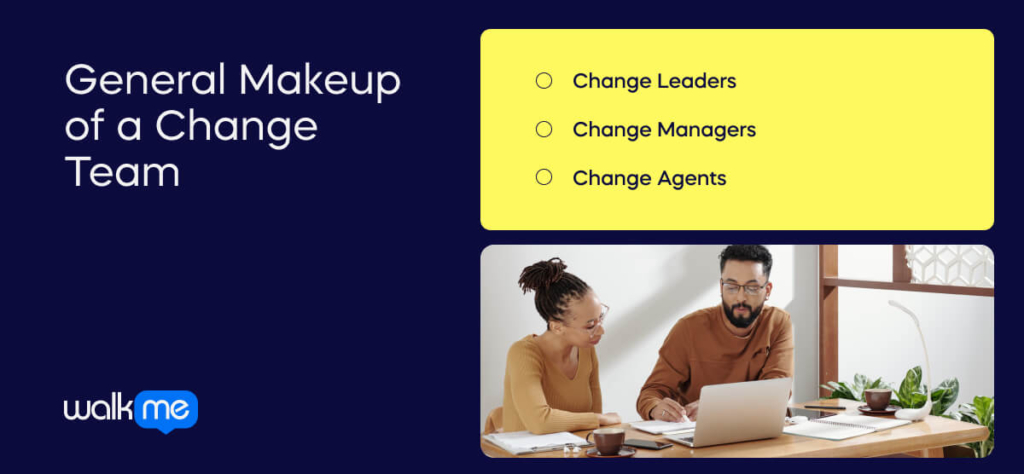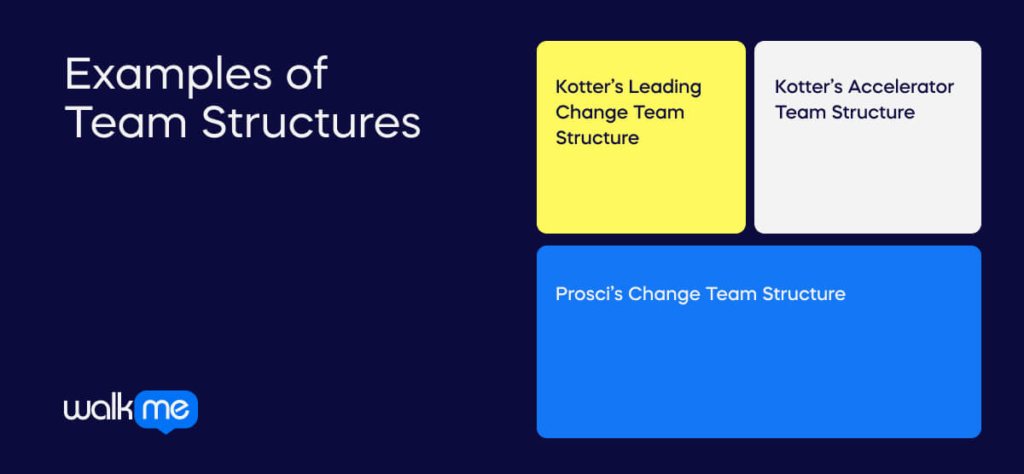Change management team structure is vitally important to the health of any change program.
When designing your change team, you will often go “by the book” of the change model you use.
However, as we’ll see below, that’s not always possible.
In cases where you need to improvise, it’s important to have a deep understanding of the team’s roles, responsibilities, and general structure.
First, we’ll look at those elements. Then, we’ll examine a few of the team structures advocated by popular change models.
How to Think About Change Management Team Structure
When it comes to change teams, there are a couple core areas that you should focus on – roles and responsibilities.
Let’s take a look at these two topics and understand why they’re so important.
Responsibilities
Before assigning roles, you need to understand the responsibilities of those involved.
That is:
- What are the problems that must be solved?
- What tasks will they be executing?
- What process, or change model, do you have in place?
Of course, you will be thinking about roles and responsibilities side-by-side. After all, the change framework will determine how you assign responsibilities and roles.
However, it’s best to map out responsibilities first and foremost.
And the reason is simple – duties that don’t get assigned don’t get done.
Effective execution of the process is paramount, so make sure you have these listed, prioritized, and planned for.
Then you can move forward with assigning roles.
Roles
The team structure you choose will often be determined by a couple things:
- Your change model
- Your organization structure
- Resource constraints
The change model, or framework, that you implement will determine the size of your change team, its composition, how many people are included, and what roles you assign.
In some cases, you can simply follow the framework to the letter.
However, resource constraints – such as time constraints, budget constraints, or limitations placed by business leaders – will force you to improvise.
General Makeup of a Change Team

Generally speaking, change teams carry the same overall purpose: to effect change.
So, regardless of the change model being used, you’ll see commonalities between the assigned roles.
Here are a few of the more common types of roles you’ll see, along with their responsibilities:
- Change Leaders—The change leader creates the vision for change and drives it. He, she, or they are the impetus that pushes the change forward.
- Change Managers – The change manager oversees and administers change initiatives.
- Change Agents – The change agent is the one enacting the change. This can be a large army of people or a few key individuals.
Naturally, these descriptions are quite broad and this is just a skeleton list.
Before implementing an initiative with these roles, it would be necessary to define them more precisely.
However, it gives an overall picture of what to look for in a change team.
Now, we’ll look at some of the most popular change team structures. After reviewing them, you can customize a team makeup that works for you.
Examples of Team Structures

Different change models take different approaches to team structures.
Therefore, it makes sense that each model would present a change team that fits with that model.
When creating your change team, it’s of course vital that your team roles match the approach taken by your change model.
Kotter’s Leading Change Team Structure
Kotter’s 8-step change model was originally developed in 1996. Since its creation, it has become one of the most popular organizational change models in the world.
The original 8-step model advocates driving change with a “small, powerful core group.”
This group would direct the change process in a very top-down, hierarchical fashion.
Kotter’s Accelerator Team Structure
In 2014, Kotter updated his existing model … and the change team.
Rather than a core change team that unilaterally directs everything, there is a “guiding coalition,” empowered by a “volunteer army.”
In this structure, the emphasis is on flatness, rather than on a top-down hierarchy.
The idea is that by distributing authority to more employees, they will be more motivated and empowered.
Prosci’s Change Team Structure
Prosci’s ADKAR model is another widely-used change framework.
Like Kotter’s 8-step model, it provides a step-by-step process for mapping out, enabling, and enacting change.
Prosci’s change team structure has 5 key roles:
- Change management resource/team
- Executives and senior managers
- Managers and supervisors
- Project team
- Project support functions
These groups are designed to work together with the ADKAR process.
Like Kotter’s original team structure, these roles have clearly defined responsibilities, within an established hierarchy.
Final Thoughts
The team makeup is critical to the success or failure of a change management initiative.
It’s necessary to ensure that all responsibilities and roles are filled. And it’s also vital to match the team structure with the change management methodology and the organizational hierarchy.
A good change team will make the initiative run smoother, more efficiently, and more effectively.

